Unit 1 What's the matter? 单元教学设计 2023-2024学年人教版八年级英语下册
文档属性
| 名称 | Unit 1 What's the matter? 单元教学设计 2023-2024学年人教版八年级英语下册 | 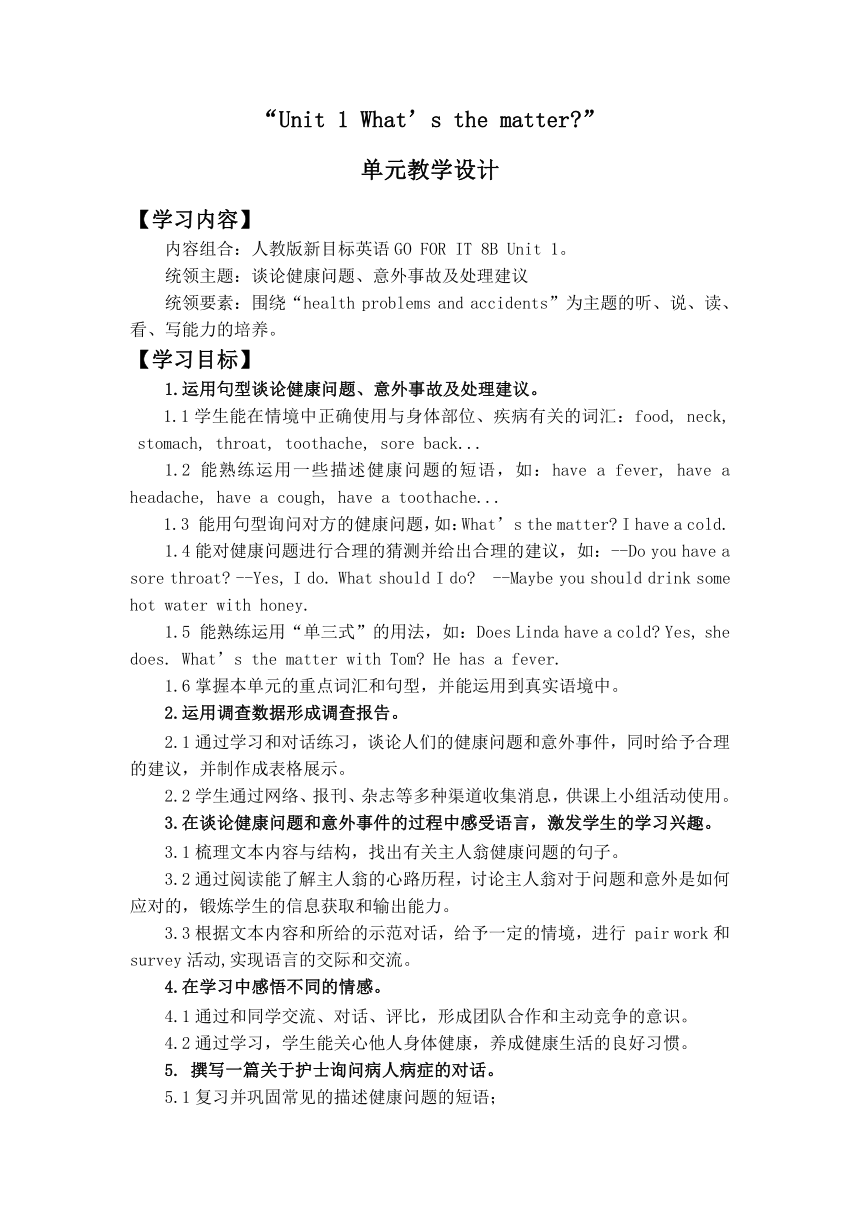 | |
| 格式 | docx | ||
| 文件大小 | 36.8KB | ||
| 资源类型 | 教案 | ||
| 版本资源 | 人教新目标(Go for it)版 | ||
| 科目 | 英语 | ||
| 更新时间 | 2024-01-29 15:02:29 | ||
图片预览

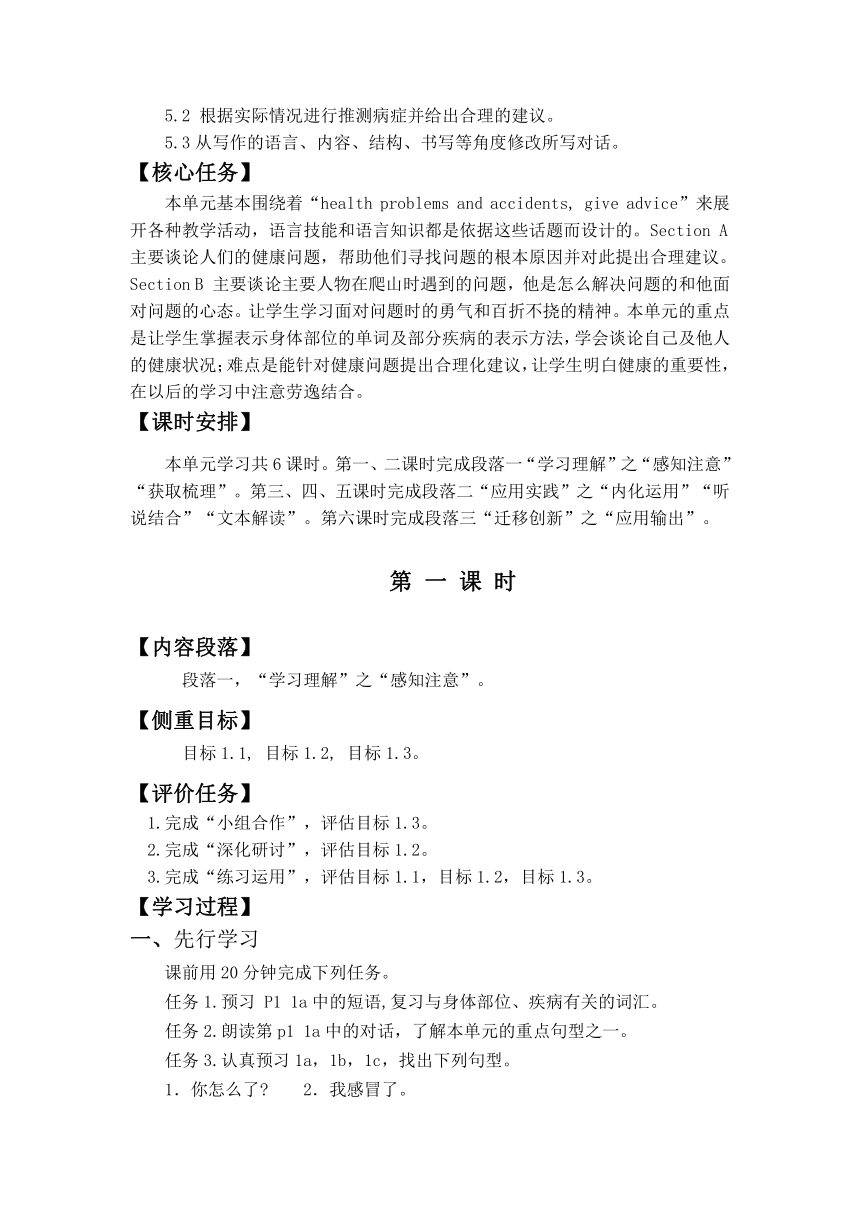
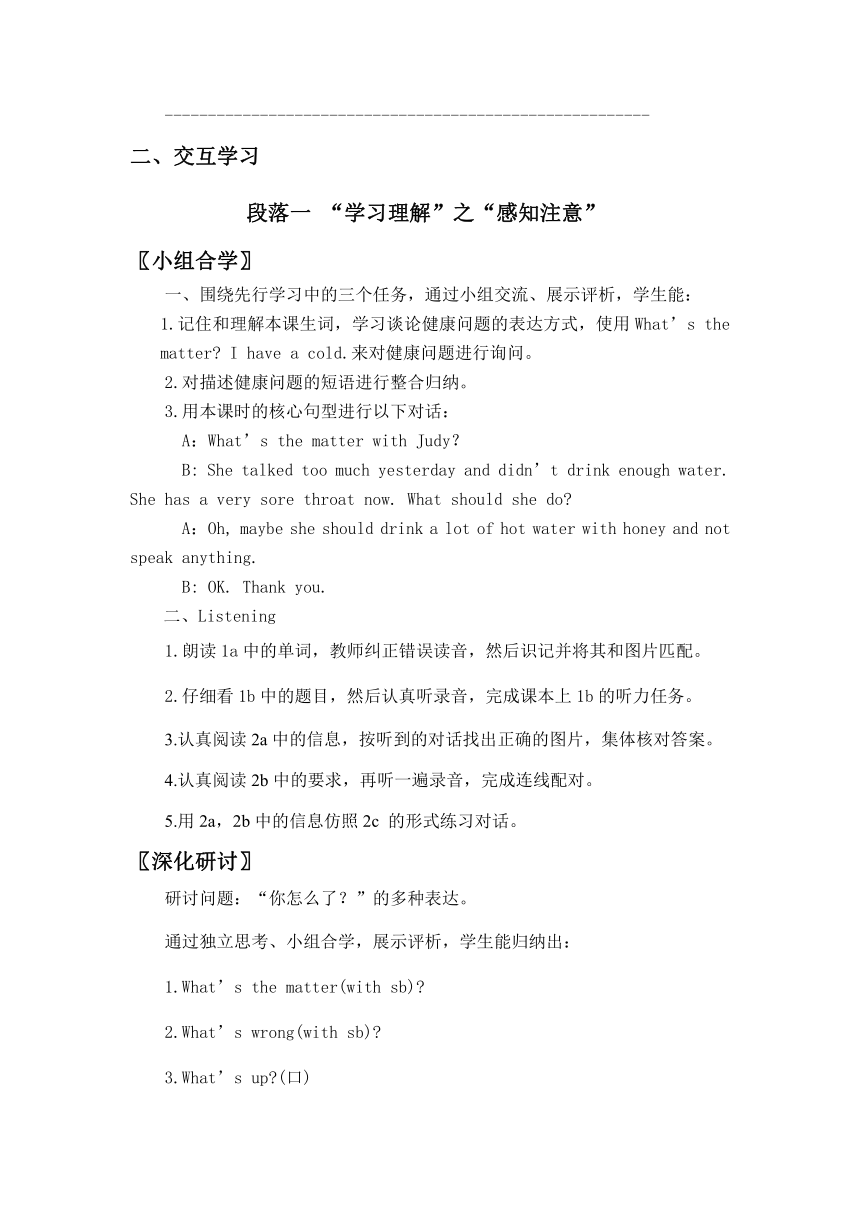
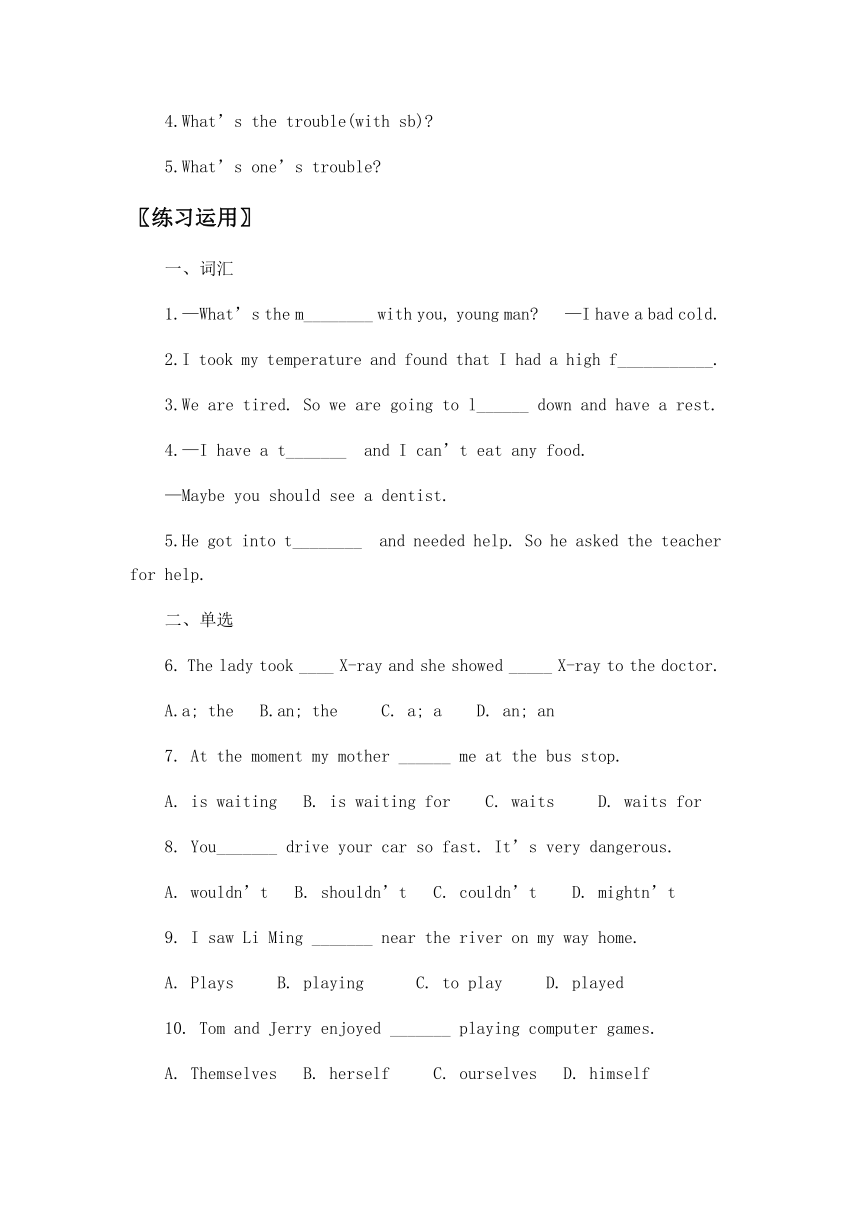
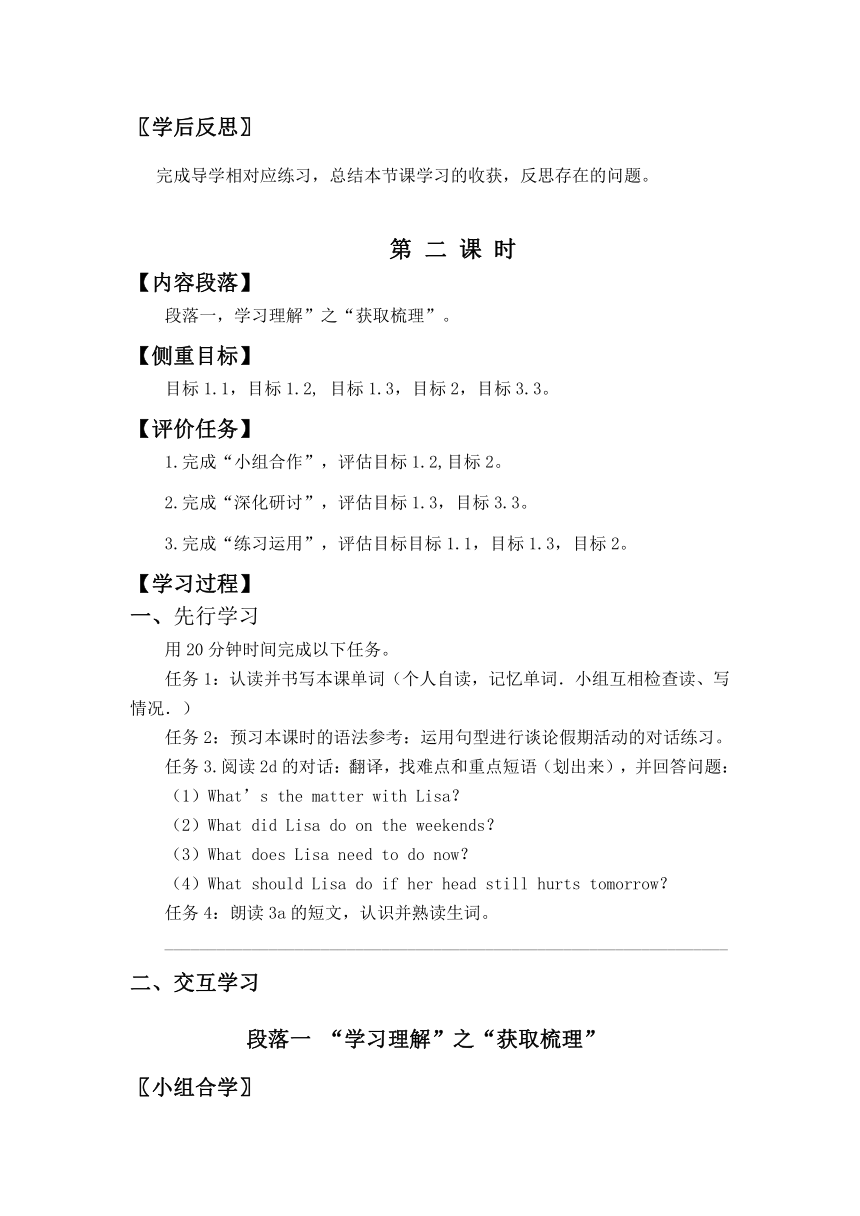
文档简介
“Unit 1 What’s the matter ”
单元教学设计
【学习内容】
内容组合:人教版新目标英语GO FOR IT 8B Unit 1。
统领主题:谈论健康问题、意外事故及处理建议
统领要素:围绕“health problems and accidents”为主题的听、说、读、看、写能力的培养。
【学习目标】
1.运用句型谈论健康问题、意外事故及处理建议。
1.1学生能在情境中正确使用与身体部位、疾病有关的词汇:food, neck, stomach, throat, toothache, sore back...
1.2 能熟练运用一些描述健康问题的短语,如:have a fever, have a headache, have a cough, have a toothache...
1.3 能用句型询问对方的健康问题,如:What’s the matter I have a cold.
1.4能对健康问题进行合理的猜测并给出合理的建议,如:--Do you have a sore throat --Yes, I do. What should I do --Maybe you should drink some hot water with honey.
1.5 能熟练运用“单三式”的用法,如:Does Linda have a cold Yes, she does. What’s the matter with Tom He has a fever.
1.6掌握本单元的重点词汇和句型,并能运用到真实语境中。
2.运用调查数据形成调查报告。
2.1通过学习和对话练习,谈论人们的健康问题和意外事件,同时给予合理的建议,并制作成表格展示。
2.2学生通过网络、报刊、杂志等多种渠道收集消息,供课上小组活动使用。
3.在谈论健康问题和意外事件的过程中感受语言,激发学生的学习兴趣。
3.1梳理文本内容与结构,找出有关主人翁健康问题的句子。
3.2通过阅读能了解主人翁的心路历程,讨论主人翁对于问题和意外是如何应对的,锻炼学生的信息获取和输出能力。
3.3根据文本内容和所给的示范对话,给予一定的情境,进行 pair work和 survey活动,实现语言的交际和交流。
4.在学习中感悟不同的情感。
4.1通过和同学交流、对话、评比,形成团队合作和主动竞争的意识。
4.2通过学习,学生能关心他人身体健康,养成健康生活的良好习惯。
撰写一篇关于护士询问病人病症的对话。
5.1复习并巩固常见的描述健康问题的短语;
5.2 根据实际情况进行推测病症并给出合理的建议。
5.3从写作的语言、内容、结构、书写等角度修改所写对话。
【核心任务】
本单元基本围绕着“health problems and accidents, give advice”来展开各种教学活动,语言技能和语言知识都是依据这些话题而设计的。Section A主要谈论人们的健康问题,帮助他们寻找问题的根本原因并对此提出合理建议。Section B 主要谈论主要人物在爬山时遇到的问题,他是怎么解决问题的和他面对问题的心态。让学生学习面对问题时的勇气和百折不挠的精神。本单元的重点是让学生掌握表示身体部位的单词及部分疾病的表示方法,学会谈论自己及他人的健康状况;难点是能针对健康问题提出合理化建议,让学生明白健康的重要性,在以后的学习中注意劳逸结合。
【课时安排】
本单元学习共6课时。第一、二课时完成段落一“学习理解”之“感知注意”“获取梳理”。第三、四、五课时完成段落二“应用实践”之“内化运用”“听说结合”“文本解读”。第六课时完成段落三“迁移创新”之“应用输出”。
第 一 课 时
【内容段落】
段落一,“学习理解”之“感知注意”。
【侧重目标】
目标1.1, 目标1.2, 目标1.3。
【评价任务】
1.完成“小组合作”,评估目标1.3。
2.完成“深化研讨”,评估目标1.2。
3.完成“练习运用”,评估目标1.1,目标1.2,目标1.3。
【学习过程】
一、先行学习
课前用20分钟完成下列任务。
任务1.预习 P1 1a中的短语,复习与身体部位、疾病有关的词汇。
任务2.朗读第p1 1a中的对话,了解本单元的重点句型之一。
任务3.认真预习1a,1b,1c,找出下列句型。
1.你怎么了 2.我感冒了。
--------------------------------------------------------
二、交互学习
段落一 “学习理解”之“感知注意”
〖小组合学〗
一、围绕先行学习中的三个任务,通过小组交流、展示评析,学生能:
1.记住和理解本课生词,学习谈论健康问题的表达方式,使用What’s the matter I have a cold.来对健康问题进行询问。
2.对描述健康问题的短语进行整合归纳。
3.用本课时的核心句型进行以下对话:
A:What’s the matter with Judy?
B: She talked too much yesterday and didn’t drink enough water. She has a very sore throat now. What should she do
A:Oh, maybe she should drink a lot of hot water with honey and not speak anything.
B: OK. Thank you.
二、Listening
1.朗读1a中的单词,教师纠正错误读音,然后识记并将其和图片匹配。
2.仔细看1b中的题目,然后认真听录音,完成课本上1b的听力任务。
3.认真阅读2a中的信息,按听到的对话找出正确的图片,集体核对答案。
4.认真阅读2b中的要求,再听一遍录音,完成连线配对。
5.用2a,2b中的信息仿照2c 的形式练习对话。
〖深化研讨〗
研讨问题:“你怎么了?”的多种表达。
通过独立思考、小组合学,展示评析,学生能归纳出:
1.What’s the matter(with sb)
2.What’s wrong(with sb)
3.What’s up (口)
4.What’s the trouble(with sb)
5.What’s one’s trouble
〖练习运用〗
一、词汇
1.—What’s the m________ with you, young man —I have a bad cold.
2.I took my temperature and found that I had a high f___________.
3.We are tired. So we are going to l______ down and have a rest.
4.—I have a t_______ and I can’t eat any food.
—Maybe you should see a dentist.
5.He got into t________ and needed help. So he asked the teacher for help.
二、单选
6. The lady took ____ X-ray and she showed _____ X-ray to the doctor.
A.a; the B.an; the C. a; a D. an; an
7. At the moment my mother ______ me at the bus stop.
A. is waiting B. is waiting for C. waits D. waits for
8. You_______ drive your car so fast. It’s very dangerous.
A. wouldn’t B. shouldn’t C. couldn’t D. mightn’t
9. I saw Li Ming _______ near the river on my way home.
A. Plays B. playing C. to play D. played
10. Tom and Jerry enjoyed _______ playing computer games.
A. Themselves B. herself C. ourselves D. himself
〖学后反思〗
完成导学相对应练习,总结本节课学习的收获,反思存在的问题。
第 二 课 时
【内容段落】
段落一,学习理解”之“获取梳理”。
【侧重目标】
目标1.1,目标1.2, 目标1.3,目标2,目标3.3。
【评价任务】
1.完成“小组合作”,评估目标1.2,目标2。
2.完成“深化研讨”,评估目标1.3,目标3.3。
3.完成“练习运用”,评估目标目标1.1,目标1.3,目标2。
【学习过程】
一、先行学习
用20分钟时间完成以下任务。
任务1:认读并书写本课单词(个人自读,记忆单词.小组互相检查读、写
情况.)
任务2:预习本课时的语法参考:运用句型进行谈论假期活动的对话练习。
任务3.阅读2d的对话:翻译,找难点和重点短语(划出来),并回答问题:
(1)What’s the matter with Lisa?
(2)What did Lisa do on the weekends?
(3)What does Lisa need to do now?
(4)What should Lisa do if her head still hurts tomorrow?
任务4:朗读3a的短文,认识并熟读生词。
_________________________________________________________________
二、交互学习
段落一 “学习理解”之“获取梳理”
〖小组合学〗
围绕先行学习中的三个任务,通过小组研讨、展示评析,学生能:
1.根据调查结果,绘制表格。
2.根据对话创编一个真实的语境,进行role-play。
3.
Pre-reading
T: When our families or friends have problems, we can give them some advice. But when you see other people you don’t know get into trouble, what should you do Please look at the picture.
T:the old man is lying on the road. He must has a health problem.Let’s read the story.
While-reading
fast reading
The general idea of this article is about______.
An accident B. a good deed C. a sad thing happening on bus
Complete 3b & 3c.
Post-reading
Read and retell the passage.
Think: Let’s discuss a question. If you see an old man lying on the road, will you give him a hand Please tell me your opinion.
T: I think we should help the people in trouble although we don’t know them. Caring for ourselves can make us healthy, but caring for others can make our hearts warm.
〖深化研讨〗
研讨问题:辨析 ache,sore,pain和hurt
通过独立思考、小组合学,学生能归纳其语法特征:
表示“痛”的英语单词,除了sore之外,意思相近的词汇还有ache,pain
和hurt.那么,这四个表示“疼痛”的单词,在实际使用上有什么不同呢?大家请看下面的详细说明:
1.ache指持续的隐隐的疼痛,常放在身体部位名词后构成病痛名称。如:
I have a toothache.我牙痛。
2.sore是形容词,通常指由于发炎而引起的肌肉疼痛,表示身体某一部位疼痛时,放在身体部位名词前面。如:I have a sore throat.我喉咙痛。
3.pain是名词,指肉体或精神上的疼痛,通常不能与身体部位名词连用,而用在动词短语中。如:I have a pain in my feet.我的脚痛。
4.hurt是动词,表示身体部位感到疼痛。如:My left leg hurts.
〖练习运用〗
翻译。
1.他在骑车时伤到了自己。He _______ when he rode a bike.
2.—怎么了?—我胃痛。 — ______the matter —I ____a stomachache.
3.那位司机看到一位老人正躺在马路的一边。
The driver _____ an old man _______ on the side of the road.
4.—What’s wrong with you —I _______(发烧).
5.Why not _____ (躺下) and have a rest
6.We are ________ (思考) how to make a model plane.
7.David _______(感冒) yesterday and he didn’t feel well.
8.You should ______(看医生) at once.
9.They arrived at the railway station ______(及时).
〖学后反思〗
1.梳理和绘制学习本单元A部分的“health problems”话题思维导图。
2.完成导学作业,总结本节课的学习收获,反思学习中存在的问题。
第 三 课 时
【内容段落】
段落二,“应用实践”之“内化运用”。
【侧重目标】
目标1.2,目标1.3,目标2.2,目标3.2,目标3.3。
【评价任务】
1.完成“小组合作”,评估目标1.2,目标1.3,目标 3.2。
2.完成“深度研学”,评估目标3.3。
3.完成“练习运用”,评估目标2.2。
【学习过程】
先行学习
课前用20分钟时间独立完成以下任务。
任务1:熟读并识记本单元的重点词汇。
任务2. 阅读Grammar Focus,并找出规律。
______________________________________
任务3:回忆情态动词should和反身代词的用法。
二、交互学习
段落二 “应用实践”之“内化运用”
〖小组合学〗
围绕先行学习中的三个任务,通过小组合学、展示评析,学生能:
1.Practice:look at the pictures, please make up conversations about them using the sentences in Grammar Focus.
2.read the sentences in Grammar Focus and find out the ways of talking about health problems and giving advice.
3.complete 4a alone.
4.ask Ss to work alone to write down the best advice to each health problem.
5.Group work: One student mimes a problem. The other student in your group guess the problem and give advice.
〖深化研讨〗
研讨问题:疾病、不适、伤情的表达方式。
通过独立思考、小组合学,学生能归纳其语法特征:
①“have a+病症”型,have意为“患有”。
She has a cough/a cold/a fever.她咳嗽/感冒/发烧。
②“have a+sore+发病部位”型,其中sore是一个独立的形容词,指的
是身体某一部位的酸痛。
I have a sore back/throat/neck.我背痛/喉咙痛/脖子疼。
③“have a+身体部位十-ache”型,-ache常与表示身体部位的名词合
成一个新词,表示身体某部位疼痛。
I have a toothache/headache/stomachache.我牙痛/头痛/胃疼。
④“There is something wrong with+one's +身体部位”型:
There is something wrong with my leg.我的腿有点问题。
⑤“hurt/cut+身体部位或反身代词”型:
He hurt his leg.他的腿受伤了。He cut himself.他割伤了自己。
⑥“be/feel+表示不适的形容词”型:
be/feel sick(tired/hot)感觉不舒服(疲劳/发热)
⑦“get+动词过去分词+in/on+身体部位”型
get cut in the hand 割伤了手
〖练习运用〗
排序。
____I hurt myself playing soccer. I have a sore leg.
____I think you should see a doctor and get an X-ray.
____What’s the matter
____What should I do
____OK, thanks. I’ll do that now.
____Oh, that doesn’t sound good.
〖学后反思〗
完成导学作业,总结本节课的学习收获,反思学习中存在的问题。
第 四 课 时
【内容段落】
段落二,“应用实践”之“听说结合”。
【侧重目标】
目标1,目标2。
【评价任务】
1.完成“小组合作”,评估目标1.6, 目标2.2,。
2.完成“练习运用”,评估目标2.1,目标2.2。
【学习过程】
一、先行学习
课前用20分钟时间独立完成以下任务:
任务1:参照预习单上的图片,认知单词及短语。
任务2:观察1a的图片,根据图片排序。
二、交互学习
段落二 “应用实践”之“听说结合”
〖小组合学〗
围绕先行学习中的两个任务,通过小组合学、展示评析,学生能:
1.教师领读词组,强调个别单词的读音,学生快速记忆词组并且两人一组互相提问。
2.认真观察图片,将图片和单词匹配,集体核对答案。完成la。
3.听录音,根据内容选择你听到的健康问题。
4.再听录音,根据内容,选择合适的治疗方案。
5.两人一组,根据听力材料,一人演绎校医,一人演绎老师,角色扮演该对话,完成ld。
〖练习运用〗
Make a survey. Let Ss work in groups of four, and then ask and answer like this:
A: What should you do when you fall down
B: I think I should go to the hospital...
A: What’s else
C: I should...
2.Next, Let Ss fill in the survey chart, and then write a short passage.
Accidents/problems Should do
Fall down Go to the hospital, get an X-ray...
Cut your knee
Hurt your back
Have a nosebleed
...
〖学后反思〗
完成导学作业,总结本节课的学习收获,反思学习中存在的问题。
第 五 课 时
【内容段落】
段落二,“应用实践”之“文本解读”。
【侧重目标】
目标3.1,目标4。
【评价任务】
1.完成“小组合学”评估目标3.1,目标4。
2.完成“练习运用”评估目标4。
【学习过程】
一、先行学习
课前用20分钟时间独立完成以下任务:
任务1:个人自读,记忆本课单词,读后小组互相检查单词阅读情况;
任务2:阅读2b短文,以小组为单位,共同找出本课中的重点内容,然后在组内交流探讨。
任务3:翻译。
1.有好多次,阿伦差点因为意外丢掉生命。
2.因为不能动手臂,他只能在那里等了五天并且希望有人能够找到他。
3.失去了手臂之后,他写了一本名为《生死两难》的书。
4.它的意思是“处于一个你似乎无法拜托的困境之中”。
任务4:Read and draw a mind-map about the context of the passage.
________________________________________________________________
交互学习
段落二 “应用实践”之“文本解读”
〖小组合学〗
围绕先行学习1-4任务,通过小组合学,展示评析,学生能:
1.掌握本单元的重点词汇。
2.能正确运用本单元的句型和表达句式,并能应用到实际情境中去。
Pre-reading
2a: read and write the letter of each sport next to each accident or problem that can happen.
2b;look at the picture in 2b, discuss the following questions.
(1)What’s the man doing
(2)What do you think of him
While-reading
Fast reading:
read for the general idea of 2b.
Read the passage and match the main idea with each paragraph.
Careful reading:
Task 1:read para.1 and draw the mind map.
Task 2:read para.2 and answer the questions.
Q1: What is the accident
Q2: What did Aron do at first(when he couldn’t free his arm)
Q3: What did Aron do when the water ran out
Q4: How did he save his own life And get the mind map.
Task 3:read para.3 and answer the questions.
Q1: What did Aron do after losing his arm
Q2: What did he tell in his book
Q3: Why did he keep on climbing mountains
Task 4:read para.4 and discuss the questions.
Q1: What’s the spirit of Aron
Q2: What is a good decision Arm or life
Q3: How to control life Wait or save
Post-reading
Complete 2c, 2d, 2e.
Summarize Aron’s story and retell it.
Have a discussion: In our real life, does anyone have the same spirit as Aron Please present some and introduce them.
〖练习运用〗
根据句意用括号内单词的适当形式填空。
1.The old woman has a serious ________ (ill).
2. He had to lie down for a while ________ (rest) his legs.
3. I have a _______ ( tooth ) because there is a cavity(洞)in one of my ______ (tooth).
4.If you want to be healthier, you must take ________ (much) exercise.
5. Mary hurt _________ ( her ) when she fell over .
〖学后反思〗
通过自我评价,量化思考,学生能找出存在问题,调整学习策略。
第 六 课 时
【内容段落】
段落三,“迁移创新”之“应用输出”。
【侧重目标】
目标3.1,目标4。
【评价任务】
1.完成“小组合学”评估目标3.1,目标4。
2.完成“练习运用”评估目标4。
【学习过程】
一、先行学习
课前用20分钟时间独立完成以下任务:
任务1:复习本单元重点词汇或短语。
任务2:运用相应的句式,谈论疾病、事故与伤害等健康问题以及相应的急救措施。
交互学习
段落三 “迁移创新”之“应用输出”
〖小组合学〗
围绕先行学习两个任务,通过小组合学,展示评析,学生能:
灵活应用重点词汇。
学会一些必要的安全常识以及一些急救方法,提升自我保护能力。
Show the picture to the Ss and make a conversation with them.
g. T: hello, boys and girls. I have a problem. I don’t feel well. Could you give me some advice
Ss: of course. What’s the matter
T: I have a bad cold. What should I do
Ss: You should see a doctor...
Learn alone:
Deal with 3a.
Make conversations.
Deal with 3b.
〖练习运用〗
Self check 1, 2, 3.
三、后续学习
1.进行第一单元的检测。
单元教学设计
【学习内容】
内容组合:人教版新目标英语GO FOR IT 8B Unit 1。
统领主题:谈论健康问题、意外事故及处理建议
统领要素:围绕“health problems and accidents”为主题的听、说、读、看、写能力的培养。
【学习目标】
1.运用句型谈论健康问题、意外事故及处理建议。
1.1学生能在情境中正确使用与身体部位、疾病有关的词汇:food, neck, stomach, throat, toothache, sore back...
1.2 能熟练运用一些描述健康问题的短语,如:have a fever, have a headache, have a cough, have a toothache...
1.3 能用句型询问对方的健康问题,如:What’s the matter I have a cold.
1.4能对健康问题进行合理的猜测并给出合理的建议,如:--Do you have a sore throat --Yes, I do. What should I do --Maybe you should drink some hot water with honey.
1.5 能熟练运用“单三式”的用法,如:Does Linda have a cold Yes, she does. What’s the matter with Tom He has a fever.
1.6掌握本单元的重点词汇和句型,并能运用到真实语境中。
2.运用调查数据形成调查报告。
2.1通过学习和对话练习,谈论人们的健康问题和意外事件,同时给予合理的建议,并制作成表格展示。
2.2学生通过网络、报刊、杂志等多种渠道收集消息,供课上小组活动使用。
3.在谈论健康问题和意外事件的过程中感受语言,激发学生的学习兴趣。
3.1梳理文本内容与结构,找出有关主人翁健康问题的句子。
3.2通过阅读能了解主人翁的心路历程,讨论主人翁对于问题和意外是如何应对的,锻炼学生的信息获取和输出能力。
3.3根据文本内容和所给的示范对话,给予一定的情境,进行 pair work和 survey活动,实现语言的交际和交流。
4.在学习中感悟不同的情感。
4.1通过和同学交流、对话、评比,形成团队合作和主动竞争的意识。
4.2通过学习,学生能关心他人身体健康,养成健康生活的良好习惯。
撰写一篇关于护士询问病人病症的对话。
5.1复习并巩固常见的描述健康问题的短语;
5.2 根据实际情况进行推测病症并给出合理的建议。
5.3从写作的语言、内容、结构、书写等角度修改所写对话。
【核心任务】
本单元基本围绕着“health problems and accidents, give advice”来展开各种教学活动,语言技能和语言知识都是依据这些话题而设计的。Section A主要谈论人们的健康问题,帮助他们寻找问题的根本原因并对此提出合理建议。Section B 主要谈论主要人物在爬山时遇到的问题,他是怎么解决问题的和他面对问题的心态。让学生学习面对问题时的勇气和百折不挠的精神。本单元的重点是让学生掌握表示身体部位的单词及部分疾病的表示方法,学会谈论自己及他人的健康状况;难点是能针对健康问题提出合理化建议,让学生明白健康的重要性,在以后的学习中注意劳逸结合。
【课时安排】
本单元学习共6课时。第一、二课时完成段落一“学习理解”之“感知注意”“获取梳理”。第三、四、五课时完成段落二“应用实践”之“内化运用”“听说结合”“文本解读”。第六课时完成段落三“迁移创新”之“应用输出”。
第 一 课 时
【内容段落】
段落一,“学习理解”之“感知注意”。
【侧重目标】
目标1.1, 目标1.2, 目标1.3。
【评价任务】
1.完成“小组合作”,评估目标1.3。
2.完成“深化研讨”,评估目标1.2。
3.完成“练习运用”,评估目标1.1,目标1.2,目标1.3。
【学习过程】
一、先行学习
课前用20分钟完成下列任务。
任务1.预习 P1 1a中的短语,复习与身体部位、疾病有关的词汇。
任务2.朗读第p1 1a中的对话,了解本单元的重点句型之一。
任务3.认真预习1a,1b,1c,找出下列句型。
1.你怎么了 2.我感冒了。
--------------------------------------------------------
二、交互学习
段落一 “学习理解”之“感知注意”
〖小组合学〗
一、围绕先行学习中的三个任务,通过小组交流、展示评析,学生能:
1.记住和理解本课生词,学习谈论健康问题的表达方式,使用What’s the matter I have a cold.来对健康问题进行询问。
2.对描述健康问题的短语进行整合归纳。
3.用本课时的核心句型进行以下对话:
A:What’s the matter with Judy?
B: She talked too much yesterday and didn’t drink enough water. She has a very sore throat now. What should she do
A:Oh, maybe she should drink a lot of hot water with honey and not speak anything.
B: OK. Thank you.
二、Listening
1.朗读1a中的单词,教师纠正错误读音,然后识记并将其和图片匹配。
2.仔细看1b中的题目,然后认真听录音,完成课本上1b的听力任务。
3.认真阅读2a中的信息,按听到的对话找出正确的图片,集体核对答案。
4.认真阅读2b中的要求,再听一遍录音,完成连线配对。
5.用2a,2b中的信息仿照2c 的形式练习对话。
〖深化研讨〗
研讨问题:“你怎么了?”的多种表达。
通过独立思考、小组合学,展示评析,学生能归纳出:
1.What’s the matter(with sb)
2.What’s wrong(with sb)
3.What’s up (口)
4.What’s the trouble(with sb)
5.What’s one’s trouble
〖练习运用〗
一、词汇
1.—What’s the m________ with you, young man —I have a bad cold.
2.I took my temperature and found that I had a high f___________.
3.We are tired. So we are going to l______ down and have a rest.
4.—I have a t_______ and I can’t eat any food.
—Maybe you should see a dentist.
5.He got into t________ and needed help. So he asked the teacher for help.
二、单选
6. The lady took ____ X-ray and she showed _____ X-ray to the doctor.
A.a; the B.an; the C. a; a D. an; an
7. At the moment my mother ______ me at the bus stop.
A. is waiting B. is waiting for C. waits D. waits for
8. You_______ drive your car so fast. It’s very dangerous.
A. wouldn’t B. shouldn’t C. couldn’t D. mightn’t
9. I saw Li Ming _______ near the river on my way home.
A. Plays B. playing C. to play D. played
10. Tom and Jerry enjoyed _______ playing computer games.
A. Themselves B. herself C. ourselves D. himself
〖学后反思〗
完成导学相对应练习,总结本节课学习的收获,反思存在的问题。
第 二 课 时
【内容段落】
段落一,学习理解”之“获取梳理”。
【侧重目标】
目标1.1,目标1.2, 目标1.3,目标2,目标3.3。
【评价任务】
1.完成“小组合作”,评估目标1.2,目标2。
2.完成“深化研讨”,评估目标1.3,目标3.3。
3.完成“练习运用”,评估目标目标1.1,目标1.3,目标2。
【学习过程】
一、先行学习
用20分钟时间完成以下任务。
任务1:认读并书写本课单词(个人自读,记忆单词.小组互相检查读、写
情况.)
任务2:预习本课时的语法参考:运用句型进行谈论假期活动的对话练习。
任务3.阅读2d的对话:翻译,找难点和重点短语(划出来),并回答问题:
(1)What’s the matter with Lisa?
(2)What did Lisa do on the weekends?
(3)What does Lisa need to do now?
(4)What should Lisa do if her head still hurts tomorrow?
任务4:朗读3a的短文,认识并熟读生词。
_________________________________________________________________
二、交互学习
段落一 “学习理解”之“获取梳理”
〖小组合学〗
围绕先行学习中的三个任务,通过小组研讨、展示评析,学生能:
1.根据调查结果,绘制表格。
2.根据对话创编一个真实的语境,进行role-play。
3.
Pre-reading
T: When our families or friends have problems, we can give them some advice. But when you see other people you don’t know get into trouble, what should you do Please look at the picture.
T:the old man is lying on the road. He must has a health problem.Let’s read the story.
While-reading
fast reading
The general idea of this article is about______.
An accident B. a good deed C. a sad thing happening on bus
Complete 3b & 3c.
Post-reading
Read and retell the passage.
Think: Let’s discuss a question. If you see an old man lying on the road, will you give him a hand Please tell me your opinion.
T: I think we should help the people in trouble although we don’t know them. Caring for ourselves can make us healthy, but caring for others can make our hearts warm.
〖深化研讨〗
研讨问题:辨析 ache,sore,pain和hurt
通过独立思考、小组合学,学生能归纳其语法特征:
表示“痛”的英语单词,除了sore之外,意思相近的词汇还有ache,pain
和hurt.那么,这四个表示“疼痛”的单词,在实际使用上有什么不同呢?大家请看下面的详细说明:
1.ache指持续的隐隐的疼痛,常放在身体部位名词后构成病痛名称。如:
I have a toothache.我牙痛。
2.sore是形容词,通常指由于发炎而引起的肌肉疼痛,表示身体某一部位疼痛时,放在身体部位名词前面。如:I have a sore throat.我喉咙痛。
3.pain是名词,指肉体或精神上的疼痛,通常不能与身体部位名词连用,而用在动词短语中。如:I have a pain in my feet.我的脚痛。
4.hurt是动词,表示身体部位感到疼痛。如:My left leg hurts.
〖练习运用〗
翻译。
1.他在骑车时伤到了自己。He _______ when he rode a bike.
2.—怎么了?—我胃痛。 — ______the matter —I ____a stomachache.
3.那位司机看到一位老人正躺在马路的一边。
The driver _____ an old man _______ on the side of the road.
4.—What’s wrong with you —I _______(发烧).
5.Why not _____ (躺下) and have a rest
6.We are ________ (思考) how to make a model plane.
7.David _______(感冒) yesterday and he didn’t feel well.
8.You should ______(看医生) at once.
9.They arrived at the railway station ______(及时).
〖学后反思〗
1.梳理和绘制学习本单元A部分的“health problems”话题思维导图。
2.完成导学作业,总结本节课的学习收获,反思学习中存在的问题。
第 三 课 时
【内容段落】
段落二,“应用实践”之“内化运用”。
【侧重目标】
目标1.2,目标1.3,目标2.2,目标3.2,目标3.3。
【评价任务】
1.完成“小组合作”,评估目标1.2,目标1.3,目标 3.2。
2.完成“深度研学”,评估目标3.3。
3.完成“练习运用”,评估目标2.2。
【学习过程】
先行学习
课前用20分钟时间独立完成以下任务。
任务1:熟读并识记本单元的重点词汇。
任务2. 阅读Grammar Focus,并找出规律。
______________________________________
任务3:回忆情态动词should和反身代词的用法。
二、交互学习
段落二 “应用实践”之“内化运用”
〖小组合学〗
围绕先行学习中的三个任务,通过小组合学、展示评析,学生能:
1.Practice:look at the pictures, please make up conversations about them using the sentences in Grammar Focus.
2.read the sentences in Grammar Focus and find out the ways of talking about health problems and giving advice.
3.complete 4a alone.
4.ask Ss to work alone to write down the best advice to each health problem.
5.Group work: One student mimes a problem. The other student in your group guess the problem and give advice.
〖深化研讨〗
研讨问题:疾病、不适、伤情的表达方式。
通过独立思考、小组合学,学生能归纳其语法特征:
①“have a+病症”型,have意为“患有”。
She has a cough/a cold/a fever.她咳嗽/感冒/发烧。
②“have a+sore+发病部位”型,其中sore是一个独立的形容词,指的
是身体某一部位的酸痛。
I have a sore back/throat/neck.我背痛/喉咙痛/脖子疼。
③“have a+身体部位十-ache”型,-ache常与表示身体部位的名词合
成一个新词,表示身体某部位疼痛。
I have a toothache/headache/stomachache.我牙痛/头痛/胃疼。
④“There is something wrong with+one's +身体部位”型:
There is something wrong with my leg.我的腿有点问题。
⑤“hurt/cut+身体部位或反身代词”型:
He hurt his leg.他的腿受伤了。He cut himself.他割伤了自己。
⑥“be/feel+表示不适的形容词”型:
be/feel sick(tired/hot)感觉不舒服(疲劳/发热)
⑦“get+动词过去分词+in/on+身体部位”型
get cut in the hand 割伤了手
〖练习运用〗
排序。
____I hurt myself playing soccer. I have a sore leg.
____I think you should see a doctor and get an X-ray.
____What’s the matter
____What should I do
____OK, thanks. I’ll do that now.
____Oh, that doesn’t sound good.
〖学后反思〗
完成导学作业,总结本节课的学习收获,反思学习中存在的问题。
第 四 课 时
【内容段落】
段落二,“应用实践”之“听说结合”。
【侧重目标】
目标1,目标2。
【评价任务】
1.完成“小组合作”,评估目标1.6, 目标2.2,。
2.完成“练习运用”,评估目标2.1,目标2.2。
【学习过程】
一、先行学习
课前用20分钟时间独立完成以下任务:
任务1:参照预习单上的图片,认知单词及短语。
任务2:观察1a的图片,根据图片排序。
二、交互学习
段落二 “应用实践”之“听说结合”
〖小组合学〗
围绕先行学习中的两个任务,通过小组合学、展示评析,学生能:
1.教师领读词组,强调个别单词的读音,学生快速记忆词组并且两人一组互相提问。
2.认真观察图片,将图片和单词匹配,集体核对答案。完成la。
3.听录音,根据内容选择你听到的健康问题。
4.再听录音,根据内容,选择合适的治疗方案。
5.两人一组,根据听力材料,一人演绎校医,一人演绎老师,角色扮演该对话,完成ld。
〖练习运用〗
Make a survey. Let Ss work in groups of four, and then ask and answer like this:
A: What should you do when you fall down
B: I think I should go to the hospital...
A: What’s else
C: I should...
2.Next, Let Ss fill in the survey chart, and then write a short passage.
Accidents/problems Should do
Fall down Go to the hospital, get an X-ray...
Cut your knee
Hurt your back
Have a nosebleed
...
〖学后反思〗
完成导学作业,总结本节课的学习收获,反思学习中存在的问题。
第 五 课 时
【内容段落】
段落二,“应用实践”之“文本解读”。
【侧重目标】
目标3.1,目标4。
【评价任务】
1.完成“小组合学”评估目标3.1,目标4。
2.完成“练习运用”评估目标4。
【学习过程】
一、先行学习
课前用20分钟时间独立完成以下任务:
任务1:个人自读,记忆本课单词,读后小组互相检查单词阅读情况;
任务2:阅读2b短文,以小组为单位,共同找出本课中的重点内容,然后在组内交流探讨。
任务3:翻译。
1.有好多次,阿伦差点因为意外丢掉生命。
2.因为不能动手臂,他只能在那里等了五天并且希望有人能够找到他。
3.失去了手臂之后,他写了一本名为《生死两难》的书。
4.它的意思是“处于一个你似乎无法拜托的困境之中”。
任务4:Read and draw a mind-map about the context of the passage.
________________________________________________________________
交互学习
段落二 “应用实践”之“文本解读”
〖小组合学〗
围绕先行学习1-4任务,通过小组合学,展示评析,学生能:
1.掌握本单元的重点词汇。
2.能正确运用本单元的句型和表达句式,并能应用到实际情境中去。
Pre-reading
2a: read and write the letter of each sport next to each accident or problem that can happen.
2b;look at the picture in 2b, discuss the following questions.
(1)What’s the man doing
(2)What do you think of him
While-reading
Fast reading:
read for the general idea of 2b.
Read the passage and match the main idea with each paragraph.
Careful reading:
Task 1:read para.1 and draw the mind map.
Task 2:read para.2 and answer the questions.
Q1: What is the accident
Q2: What did Aron do at first(when he couldn’t free his arm)
Q3: What did Aron do when the water ran out
Q4: How did he save his own life And get the mind map.
Task 3:read para.3 and answer the questions.
Q1: What did Aron do after losing his arm
Q2: What did he tell in his book
Q3: Why did he keep on climbing mountains
Task 4:read para.4 and discuss the questions.
Q1: What’s the spirit of Aron
Q2: What is a good decision Arm or life
Q3: How to control life Wait or save
Post-reading
Complete 2c, 2d, 2e.
Summarize Aron’s story and retell it.
Have a discussion: In our real life, does anyone have the same spirit as Aron Please present some and introduce them.
〖练习运用〗
根据句意用括号内单词的适当形式填空。
1.The old woman has a serious ________ (ill).
2. He had to lie down for a while ________ (rest) his legs.
3. I have a _______ ( tooth ) because there is a cavity(洞)in one of my ______ (tooth).
4.If you want to be healthier, you must take ________ (much) exercise.
5. Mary hurt _________ ( her ) when she fell over .
〖学后反思〗
通过自我评价,量化思考,学生能找出存在问题,调整学习策略。
第 六 课 时
【内容段落】
段落三,“迁移创新”之“应用输出”。
【侧重目标】
目标3.1,目标4。
【评价任务】
1.完成“小组合学”评估目标3.1,目标4。
2.完成“练习运用”评估目标4。
【学习过程】
一、先行学习
课前用20分钟时间独立完成以下任务:
任务1:复习本单元重点词汇或短语。
任务2:运用相应的句式,谈论疾病、事故与伤害等健康问题以及相应的急救措施。
交互学习
段落三 “迁移创新”之“应用输出”
〖小组合学〗
围绕先行学习两个任务,通过小组合学,展示评析,学生能:
灵活应用重点词汇。
学会一些必要的安全常识以及一些急救方法,提升自我保护能力。
Show the picture to the Ss and make a conversation with them.
g. T: hello, boys and girls. I have a problem. I don’t feel well. Could you give me some advice
Ss: of course. What’s the matter
T: I have a bad cold. What should I do
Ss: You should see a doctor...
Learn alone:
Deal with 3a.
Make conversations.
Deal with 3b.
〖练习运用〗
Self check 1, 2, 3.
三、后续学习
1.进行第一单元的检测。
同课章节目录
- Unit 1 What's the matter?
- Section A
- Section B
- Unit 2 I'll help to clean up the city parks.
- Section A
- Section B
- Unit 3 Could you please clean your room?
- Section A
- Section B
- Unit 4 Why don't you talk to your parents?
- Section A
- Section B
- Unit 5 What were you doing when the rainstorm came
- Section A
- Section B
- Review of Units 1-5
- Unit 6 An old man tried to move the mountains.
- Section A
- Section B
- Unit 7 What's the highest mountain in the world?
- Section A
- Section B
- Unit 8 Have you read Treasure Island yet?
- Section A
- Section B
- Unit 9 Have you ever been to a museum?
- Section A
- Section B
- Unit 10 I've had this bike for three years.
- Section A
- Section B
